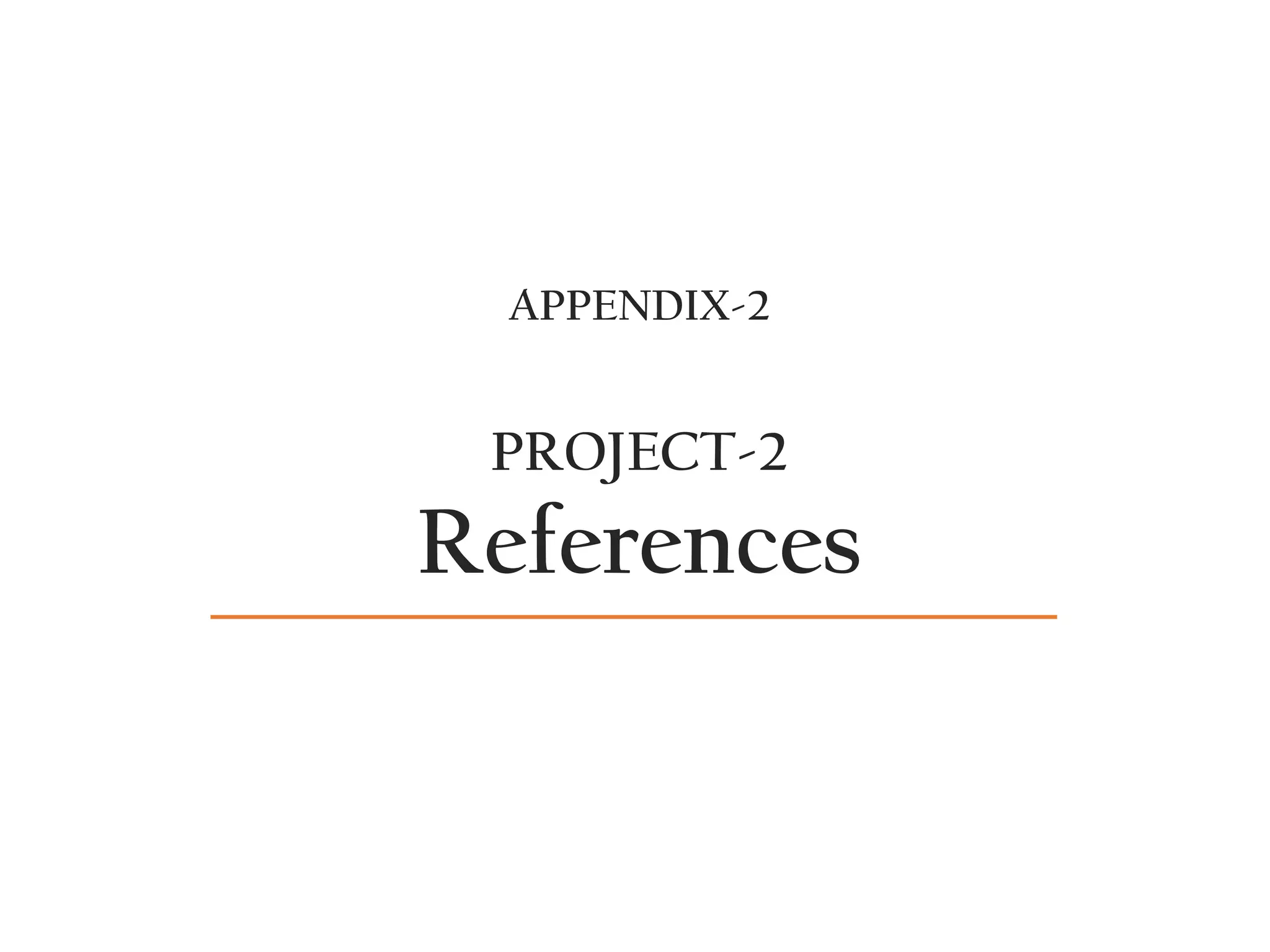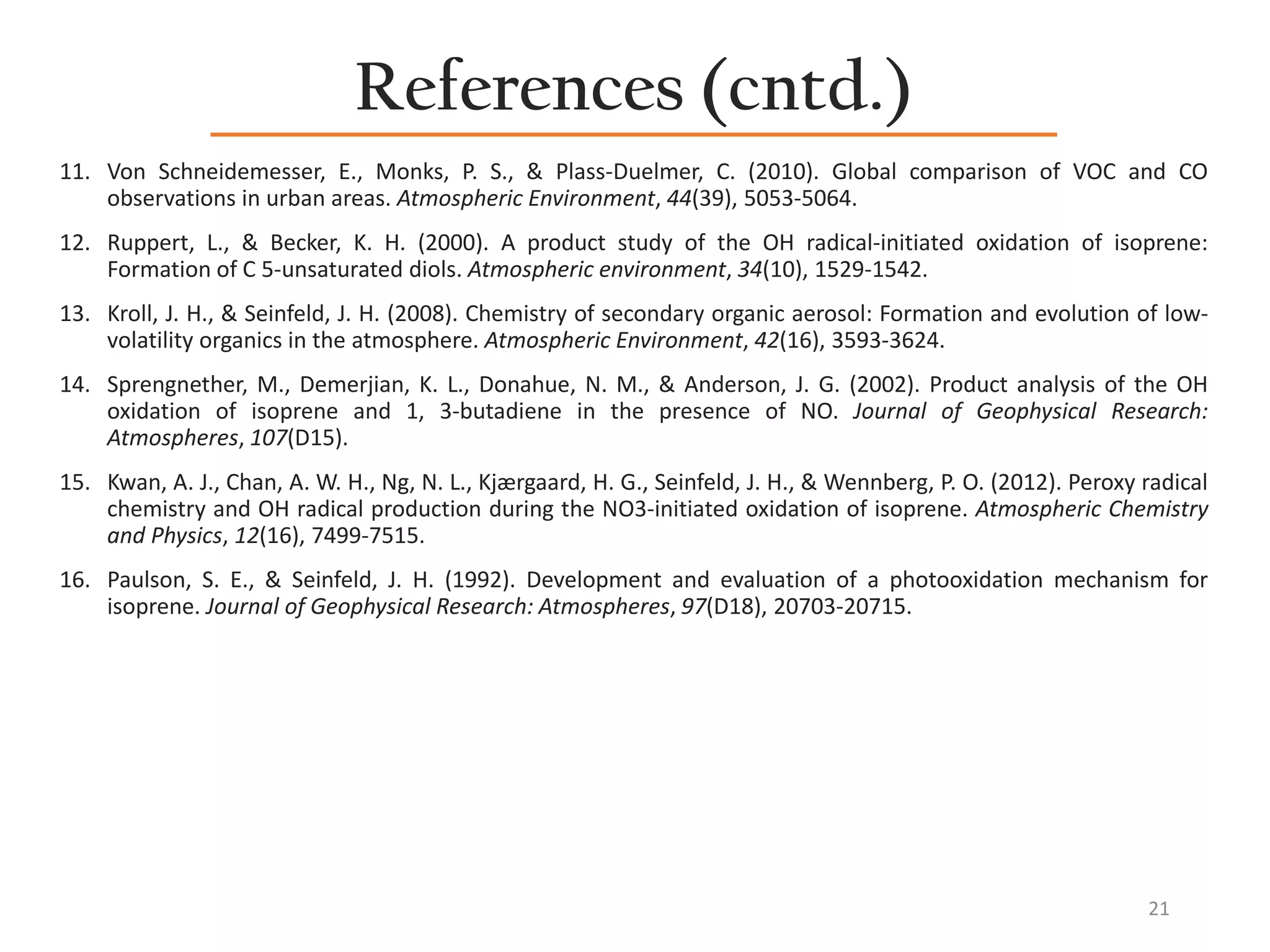This document summarizes two scientific research projects:
1. Project 1 analyzes daily ozone concentration data in Tampa-St.Petersburg region using non-parametric statistical techniques like ANOVA due to non-normally distributed data. It finds significant variation among days with some day pairs like Saturday differing from others.
2. Project 2 investigates gas-phase oxidation products of isoprene under varying conditions like NOx levels. It identifies key products like methacrolein and methyl vinyl ketone and observes greater MVK formation with NOx. Challenges in fully understanding peroxy radical and secondary reactions are also noted.
3. The projects differ in their approach, with Project 1 taking an analytical

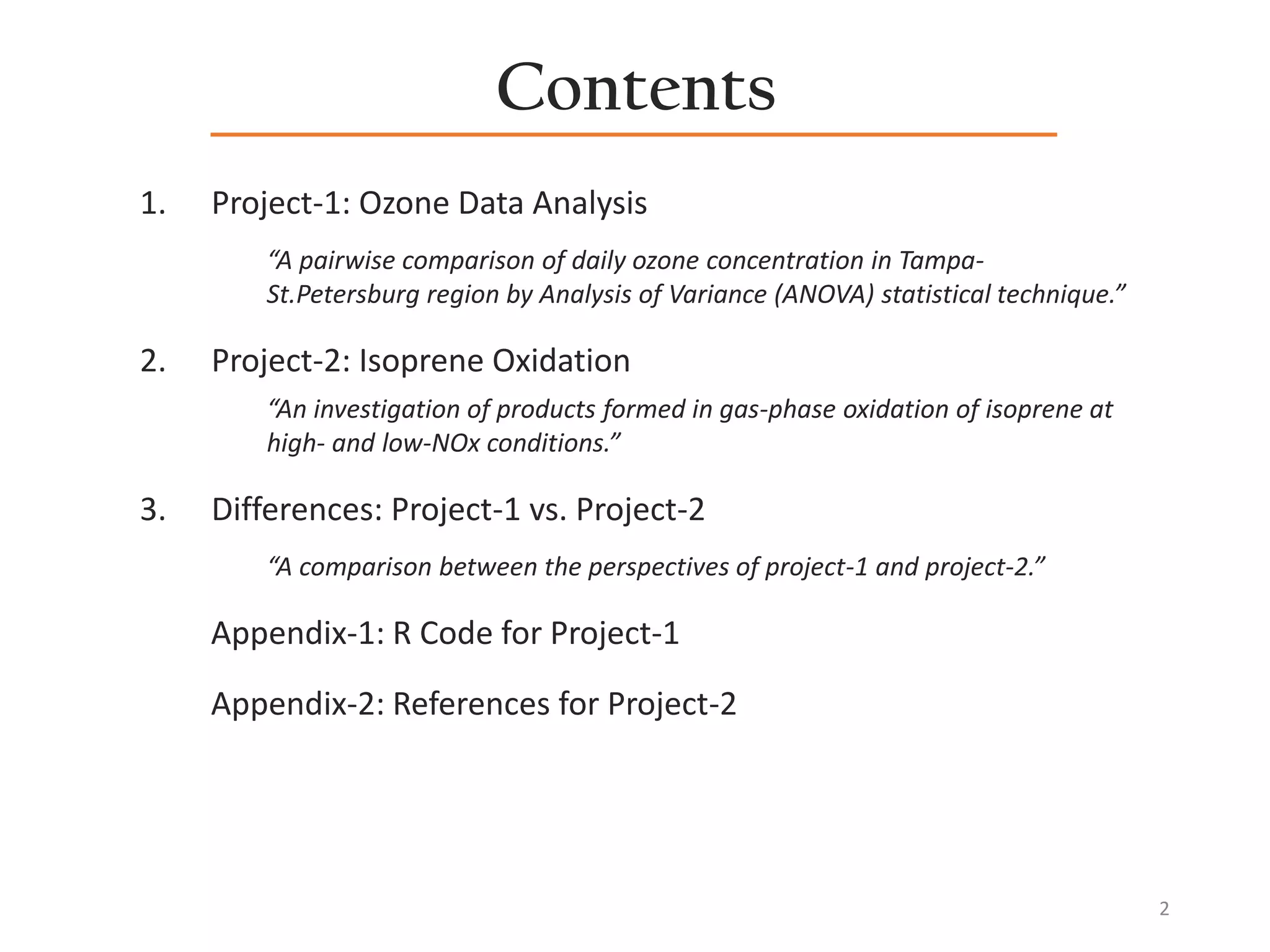

![Part-2 Plots by Group
for each treatment
Pairwise Comparison of Daily Ozone Concentration in
Tampa-St.Petersburg Region
Kalaivanan Murthy, MS
Department of Environmental Engineering Sciences, University of Florida
Kalaivanan Murthy
Email: kalaivananmurthy@ufl.edu
Website: https://www.linkedin.com/in/km007
Phone: (352) 870-2352
Contact
1. Altshuler, S. L., Arcado, T. D., & Lawson, D. R. (1995).Weekday vs. weekend ambient ozone concentrations: discussion and hypotheses with focus on northern California. Journal of the Air & Waste ManagementAssociation,45(12), 967-972.
2. Heuss, J. M., Kahlbaum, D. F., & Wolff, G. T. (2003).Weekday/weekend ozone differences: what can we learn from them?. Journal of the Air & Waste ManagementAssociation, 53(7), 772-788.
3. Ott, R. L., & Longnecker, M. T. (2015).Chapter-8 Inferences about more than two population central values, An introduction to statistical methods and data analysis, pp 402-450.Nelson Education.
4. Mächler, M. (n.d.). Friedman Rank Sum Test. Retrieved October 09, 2017, from https://stat.ethz.ch/R-manual/R-devel/library/stats/html/friedman.test.html
5. Zimmerman,D. W., & Zumbo, B. D. (1993).Relative power of the Wilcoxon test, the Friedman test, and repeated-measures ANOVA on ranks. The Journal of Experimental Education,62(1), 75-86.
6. “Air Data: Air Quality Data Collected at Outdoor Monitors Across the US.” Environmental Protection Agency, 12 Sept. 2017, www.epa.gov/outdoor-air-quality-data.
References
The variation of ozone by day has grabbed the
attention of scientists in recent times.[1][2] This
project aims to examine this variation by statistical
methods.
Hourly ozone data is downloaded from EPA and non-
parametric methods are applied to examine the
trend. Non-parametric methods are used because
the residuals are not normally distributed.
Kruskal-Wallis, a non-parametric 1-way ANOVA test,
is used to identify variation among days.[3] Friedman,
a non-parametric 2-way ANOVA test, is used to
identify the variation between a pair of days.[4]
Introduction
Objective
Results
The results convey the following points.
1. Summary Statistics. The central tendency (mean,
mean, mode) and box-and-whisker plot show that
the data is positive-skewed. This implies an
asymmetric distribution, and that the outliers are
greater than the mean. (mode<median<mean =
positive-skewed, also known as right-skewed.)
2. ANOVA and Normality. The student’s
t-distribution based ANOVA results are invalidated
by the non-normal residuals, and this was
confirmed by Anderson-Darling test. This
necessitates use of non-parametric methods, and
implies that distribution of ozone concentration
by time is not bound to z- or t-distribution.
3. Plots by Group. The group effect is very evident
for treatments month and hour but scant for day
and not evident. This prompts use of advanced
statistical methods to study the day effect.
4. Test for Group Variation. Kruskal-Wallis test,
which is a non-parametric one-way ANOVA test,
shows that day effect is significant at 5%
significance level. Friedman test, which is a non-
parametric two-way ANOVA test, shows ‘what
pairs of days differ.’ The list of p-values and their
inference is provided in the table below.
Discussion
MON TUE WED THU FRI SAT SUN
MON - 0.000 0.683 0.102 0.004 0.000 0.001
TUE 0.000 - 0.000 1.000 0.000 0.000 0.221
WED 0.683 0.000 - 0.014 0.414 0.000 0.000
THU 0.102 1.000 0.014 - 0.683 0.001 0.414
FRI 0.004 0.000 0.414 0.683 - 0.000 0.414
SAT 0.000 0.000 0.000 0.001 0.000 - 0.000
SUN 0.001 0.221 0.000 0.414 0.414 0.000 -
This project aims to answer two main questions
about daily ozone concentration.
1. Is there any significant variation among days?
2. If yes, what pairs of days differ? (For e.g., ‘is
Monday same as Friday?’)
Table 4.1 Friedmanp-values for each pair of days. Grey cells ⇒ days that ‘differ’.
Dr. Chang-Yu Wu, Professor and Assc. Chair, EES, UF.
Dr. Barron Henderson, former Asst. Professor, EES, UF.
Dr. Lawrence H. Winner, Professor, Statistics, UF.
Dr. Demetris Athienitis, Lecturer, Statistics, UF.
Acknowledgements
• The procedure can be extended to other variables
such as site-location, year, month, and hour; and
for other pollutants, particularly, PM2.5.
• The results can be combined with land-use and
urban activity; and spatial and temporal
association of air pollution can be studied.
Future Directions
Methodology
The data is screened for missing values and outliers.
It is then is factored (categorized) by the following
factors – site, year, month, day, and hour. Following
the data screening, the analysis is carried out in four
steps.
1. Summary Statistics. Basic analysis is performed
and key statistical parameters are determined.
2. ANOVA and Normality. ANOVA is run and the
resulting residuals are tested for normality using
Anderson-Darling test and Q-Q plot. The residuals
are found to violate normality. Hence, non-
parametric test is used.
3. Plots by Group. The data is plotted by groups for
the five treatments. (group=Mon, Tue, etc.;
treatment=year, month, day, etc.)
4. Test for Group Variation. The data is tested for
treatment effect for ‘day’ using Kruskal-Wallis
test. Once the day effect is confirmed, i.e., there
exists significant difference amongdays, pairwise
comparison is performed for all pairs of days using
Friedman test. Both Kruskal-Wallis and Friedman
are non-parametric tests, which can be applied
for non-normal data.[5]
Part-1 Summary Statistics
1.1 Summary Statistics
Mean 0.028 Median 0.027
Mode 0.014 Range [0, 0.104]
SD 0.014 IQR [0.018, 0.038]
(unit: parts per million volume)
Part-3 ANOVA and Normality
3.1 ANOVA
3.2.1 Normality: Anderson-Darling
p-value=3.7e-24 < 0.05
⇒ Ha: Normality is violated.
⇒ Ha: Normality is violated.
Part-4 Test for Group Variation
4.1 Kruskal-Wallis: ‘Is there variationamong days?’
p-value=1.2e-60 < 0.05 ⇒ Reject H0.
⇒ Accept Ha: Significant variation exists among days.
4.2 Friedman: ‘What pair of days differ?’
group factor: day, block factor: hour
For the pair, say, Monday-Friday,
p-value=0.004 < 0.05 ⇒Reject H0: The groups are same.
⇒ Accept Ha: Significant difference exists between the
two groups(Mon, Fri).
The p-values for other pairs are given in the table.
The project concludes the following hypothesis.
1. There is a significant variation among days.
2. The pairs of days that differ are shown as grey
color in the table.
In particular, Saturday is different from all other
days. The plots also show evidence that there is a
significant variation among years, months and hours.
Conclusion
Figure 2.1. Ozone vs. Site-Location.
Figure 2.4. Ozone vs. Month.
Figure 2.5. Ozone vs. Hour.
Poster Number
4Florida A&WMA
53rd Annual Conference
& Exhibition
Figure 1.1. Box-and-whiskerplot.
Figure 3.1. Normal Q-Q Plot.
Fig. 2.3. O3 vs. Year.
https://goo.gl/wumGJL
Figure 2.2. Ozone vs. Day.](https://image.slidesharecdn.com/approachesv4-200505234643/75/Approaches-in-Scientific-Research-4-2048.jpg)

![Overview
• Objective: to study the pathways, products, and yields of gas-phase oxidation
of isoprene under different conditions.
• Isoprene (C5H8): the most reactive hydrocarbon, the most abundant non-
methane hydrocarbon, an alkene, source – biogenic (plants and trees) under
sunlight, global generation – 550 Tg/yr.
• Oxidants: [OH·], [O3], [NO3·] (“·” denotes radical)
• Major Products: methacrolein (C4H6O), methyl vinyl ketone (C4H6O),
formaldehyde (HCHO), and nitratocarbonyl.
6
Isoprene
(2-methyl-1,3-buta-diene)
Methacrolein
(2-methyl-prop-2-enal)
Methyl vinyl ketone
(but-3-en-2-one)](https://image.slidesharecdn.com/approachesv4-200505234643/75/Approaches-in-Scientific-Research-6-2048.jpg)
![Oxidation Products
• Isoprene + OH: kOH = 2.54 x 10-11 exp(410 / T)[5] cm3 molecule-1 s-1 100E-12 (298K)
• Isoprene + O3: kO3
= 7.86 x 10-15 exp(-1913 / T)[5] cm3 molecule-1 s-1 0.00001E-12 (298K)
MACR MVK
From OH:
0.23[3]
From OH:
0.32[14]
From O3:
0.39[9]
From O3:
0.16[9]
From NO3:
0.02[15]
From NO3:
0.05[15]
Reactivity with:
OH : 0.33*kOH
[9]
O3 : 0.09*kO3
[9]
Reactivity with:
OH : 0.19*kOH
[9]
O3 : 0.36*kO3
[9]
• MVK/MACR = 3:2
• ISOP MACR MVK are less
reactive to O3.
• But [O3] > [OH], O3 oxidation
is significant.
• MACR is more reactive to OH,
whereas MVK is more reactive
to O3.
• OH reaction more sensitive to
temperature.
• In absence of NOx,
MVK/MACR = 0.8.
• MACR MVK oxidation by NO3
is negligible.
7](https://image.slidesharecdn.com/approachesv4-200505234643/75/Approaches-in-Scientific-Research-7-2048.jpg)
![Oxidation Pathways: NO3 , HO2
Isoprene + NO3:
• k = 0.66E-12298K
[15]
• NO2 reacts with O3 to form nitrate radicals
NO3·, which oxidizes isoprene to form
condensable SOA.
• Products formed:
Nitrooxycarbonyl
Hydroxynitrate
• Minor products include hydroxycarbonyl,
MACR MVK and HCHO.
RO2 + HO2
• k = 3.4 x 10-13 exp (800 / T) cm3 molecule s-1
• C5 unsaturated dihydroxy compounds (diols).
(Rupert and Becker, 2000). This provides
evidence for peroxy radical reactions. (Diol –
OH–R–OH)
• Oxidation products of peroxy radicals:
carboxylic acids –COOH, organic nitrate –ONO2,
alkoxy radical RO·, produces products of low
volatility, and hence formation of SOA.[13]
Peroxy Radical Reactions [k] cm3 molecule-1 s-1 [15]
RO2 + HO2 → ROOH + O2 k = 22E-12 (22*10-12)
RO2 + NO → RO + NO2 k = 4E-12
[12]
RO2 + NO → RONO2 ..organic nitrate
RO2 + NO2 → ROONO2m k = 9E-12 ..peroxy nitrate
RO2 + RO2 → 2RO + O2 k = 0.1E-12
60% yield
O2NO–R–C=O
O2NO–R–OH
8](https://image.slidesharecdn.com/approachesv4-200505234643/75/Approaches-in-Scientific-Research-8-2048.jpg)

![Challenges
• Second generation reactions.
• Although oxidation of MACR MVK by [O3] and [NO3] are ignored, the reactions
are found to exist.
• Photolysis of primary oxidation products.
• Recent studies show that even MACR and MVK undergo photolysis.
• Peroxy Radical reactions are less understood.
• In the absence NOx, the RO2-RO2 and RO2-HO2 reactions are significant but the
mechanisms and yields of the products are yet unclear.
• Condensed mechanisms and ‘representative compounds’
• Acetaldehyde and propanal for carbonyl oxidation products disguises the true
property of alkyl compounds.
10](https://image.slidesharecdn.com/approachesv4-200505234643/75/Approaches-in-Scientific-Research-10-2048.jpg)

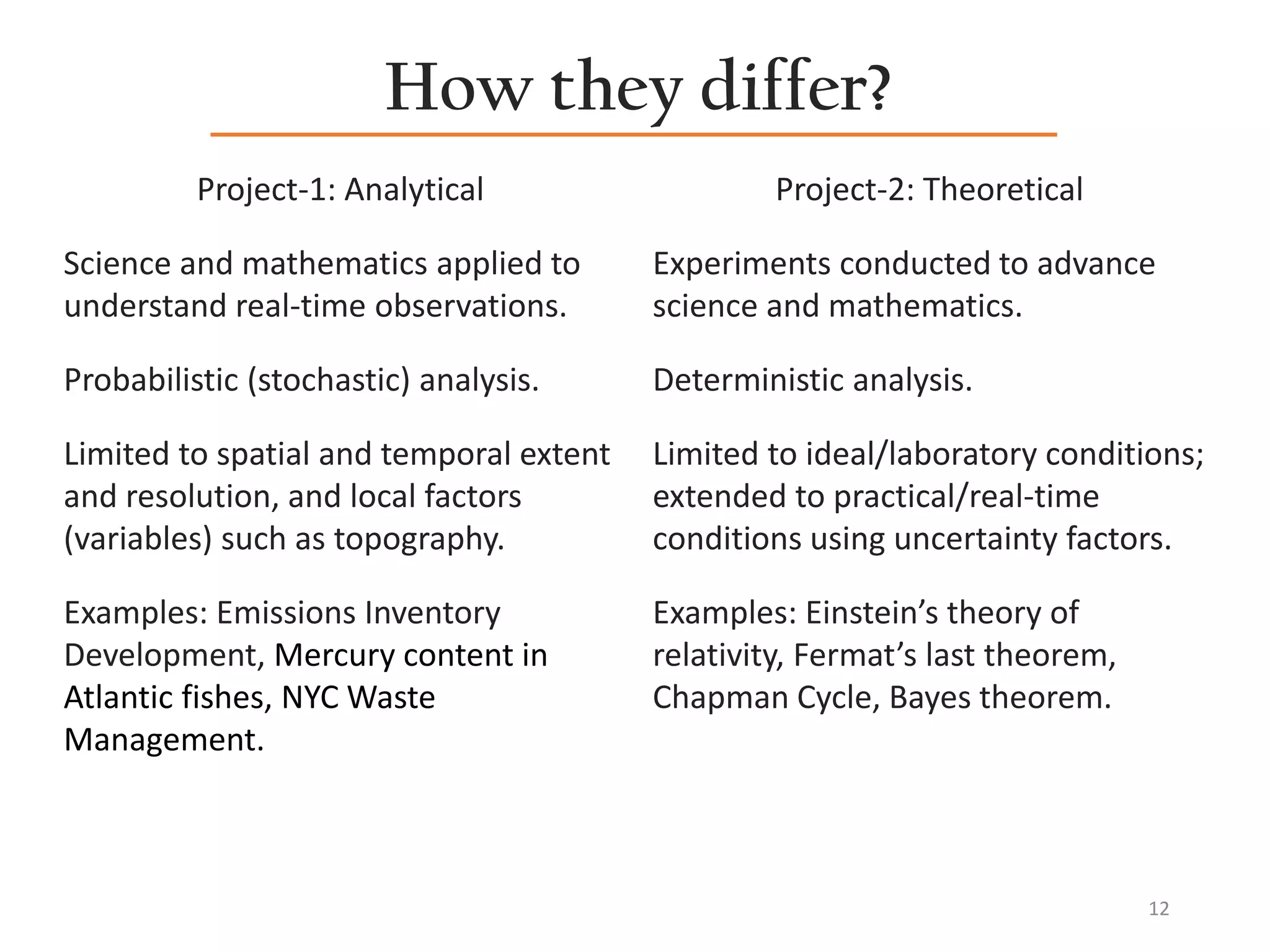


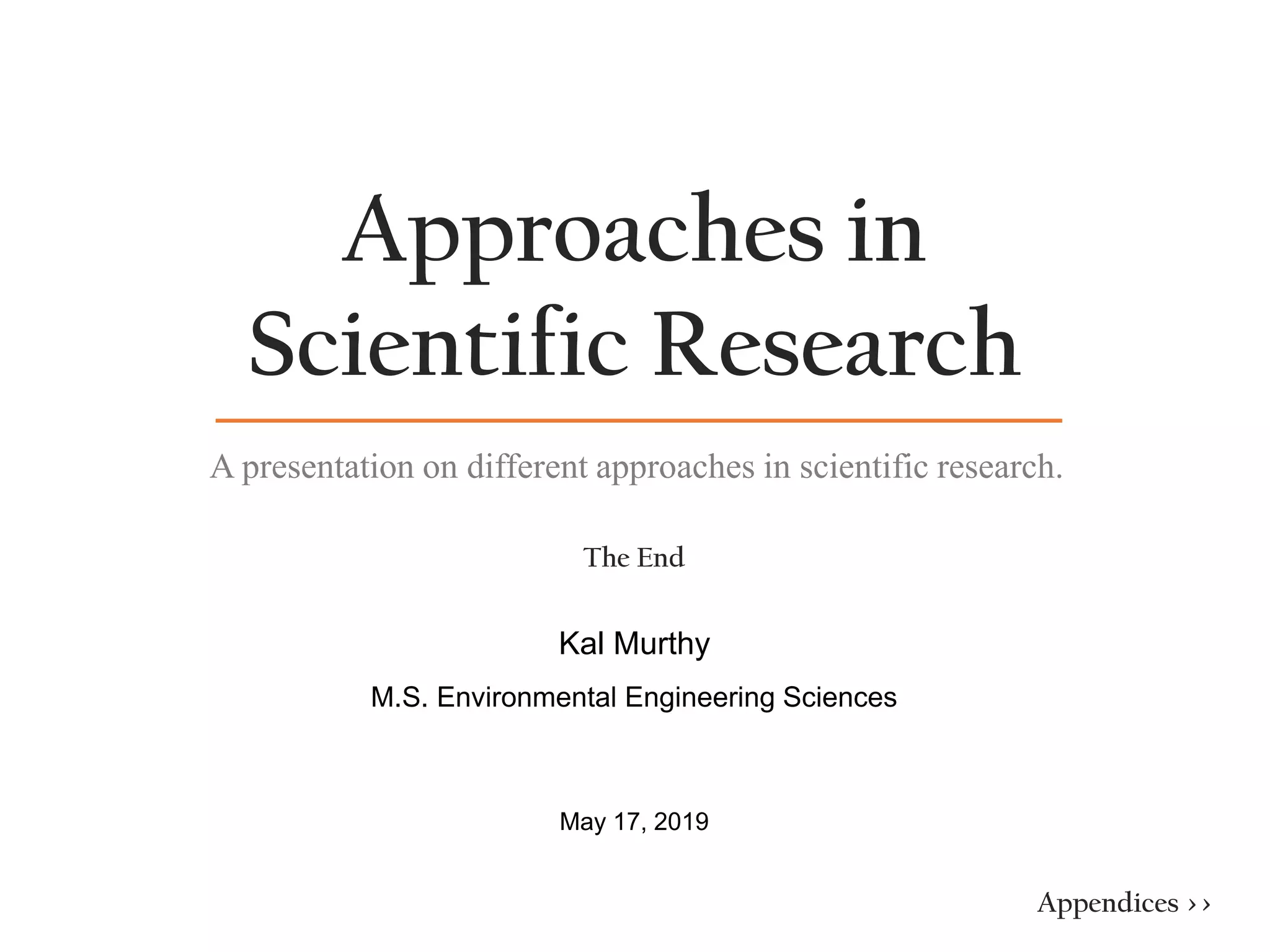

![R Code
#READ DATA AND BUILD DATAFRAME
data.raw=read.csv("C:/Users/kalsv/Documents/DATA/tampa/to_
database.txt",header=T,
stringsAsFactors=F)
s=stringr::str_split_fixed(data.raw$datetime,"[T-]",3)
date.s=strptime(s[,1],"%Y%m%d")
data.xc=data.frame(siteid=factor(data.raw$site),date.s,
day=factor(weekdays(date.s)),
month=factor(format(date.s,"%B")),
year=factor(format(date.s,"%Y")),
hour=factor(s[,2]),value=data.raw$value)
attach(data.xc)
str(data.xc)
#FACTOR DATA: SORT FACTOR LEVELS
siteid=factor(siteid,levels=c("840120571065","840120571035
","840120570081","840120573002",
"840121030004","840121030018","840121035002"),
labels=c("T-USMC","T-Davis","T-
EGSPrk","T-Sydney",
"SP-SPJrCol","SP-AzaPrk","SP-
JCPrk"))
levels(month)=c("January","February","March","April",
"May","June","July","August",
"September","October","November","December")
levels(day)=c("Monday","Tuesday","Wednesday","Thursday",
"Friday","Saturday","Sunday")
#SUMMARY STATISTICS
summary(value)
unique(value)[which.max(tabulate(match(value,
unique(value))))] #mode
range(value)
sd(value)
boxplot(value,main="Box-and-whisker",xlab="ozone (ppm)",
horizontal=T, varwidth=1, cex.axis=1, cex.lab=1)
#ANOVA: INDEPENDENT FACTORS
anova.xc=aov(value~siteid+year+month+day+hour)
summary(anova.xc)
#MEANS BY GROUP (SITE,YEAR,MONTH,DAY,HOUR)
means.func=function(factor,trimx=0.05,roundx=4) {
means.x=tapply(value,factor,mean,trim=trimx)
return(round(means.x,digits=roundx))
}
means.func(year)
means.func(month)
means.func(day)
means.func(hour,roundx=3)
#PLOTS BY GROUP (SITE,YEAR,MONTH,DAY,HOUR)
plot.func=function(factor) {
stripchart(value~factor,method="stack",vertical=TRUE,
pch=1,cex=0.0001,xlab=as.character(substitute(factor)),yla
b="ozone(ppm)",
ylim=c(0,0.05),main="Ozone Trend (2014-
2016)",col="gray")
title(sub="Pre-Analysis Plot",adj=0,cex=0.1)
points(c(1:length(levels(factor))),tapply(value,factor,mea
n,trim=0.05),col=2,pch=8)
for (i in 1:length(levels(factor))) {
avg=tapply(value,factor,mean,trim=0.05)[i]
stdev=tapply(value,factor,sd)[i]
arrows(i,avg-
stdev,i,avg+stdev,length=0.05,angle=90,code=3,col=16,lwd=0
.6)
}
abline(h=mean(value,trim=0.05),lty=2,lwd=1.2,col=2)
legend("bottomright",inset=0.02,
c("ozone
(ppm)",paste(as.character(substitute(factor)),"mean",sep="
"),"overall mean"),
col=c(152,2,2),text.col="black",lty=c(0,0,2),pch=c(1,8,NA)
,bg="gray99")
}
plot.func(siteid)
plot.func(year)
plot.func(month)
plot.func(day)
plot.func(hour)
#TEST FOR NORMALITY: ANDERSON-DARLING
normality.func=function(vector.sample) { #
vector.sample is an error vector
qqnorm(vector.sample,datax=TRUE,cex.lab=1.5)
qqline(vector.sample,datax=TRUE)
p.norm=nortest::ad.test(vector.sample)$p.value
norm=ifelse(nortest::ad.test(vector.sample)$p.value<=0.05,
"Ha:Normality Violated","Ho:Normality
Verified")
paste(norm," ","p-value=",p.norm)
}
normality.func(anova.xc$residuals)
#KRUSKAL-WALLIS TEST: NON-PARAMETRIC 1-WAY TEST
krtest.func=function(kvalue,kgroup) { # kvalue is a
numeric vector of values
# kgroup is a
group factor
kr=kruskal.test(kvalue~kgroup)
ifelse(kr$p.value<=0.05,
"Ha:Groups significantly differ","Ho:Groups are
alike")
paste(kr$p.value)
}
krtest.func(value,day)
krtest.func(value,month)
#FRIEDMAN TEST: NON-PARAMETRIC 2-WAY TEST
agg.x<-aggregate(value~day+hour,FUN="mean")
kalday.func=function(xday1,xday2) {
df.x=data.frame(agg.x[agg.x$day %in% c(xday1,xday2),])
df.x$day=factor(df.x$day);levels(df.x$day)
fr.x=friedman.test(value~day|hour,data=df.x)
fr.out=ifelse(fr.x$p.value<=0.05,
"Ha:Different","Ho:Same")
return(paste(fr.out," p-value=",round(fr.x$p.value,3)))
}
pair.func=function() {
for (i in levels(day)) {
for (j in levels(day)) {
while (i!=j) {
print(paste(i,"-",j,kalday.func(i,j)))
break
}}}
}
pair.func()
17](https://image.slidesharecdn.com/approachesv4-200505234643/75/Approaches-in-Scientific-Research-17-2048.jpg)
![Specific Modules
#READ DATA AND BUILD DATAFRAME
data.raw=read.csv("C:/Users/kalsv/Documents/DATA/tampa/to_databa
se.txt",header=T,stringsAsFactors=F)
s=stringr::str_split_fixed(data.raw$datetime,"[T-]",3)
date.s=strptime(s[,1],"%Y%m%d")
data.xc=data.frame(siteid=factor(data.raw$site),date.s,
day=factor(weekdays(date.s)),
month=factor(format(date.s,"%B")),
year=factor(format(date.s,"%Y")),
hour=factor(s[,2]),value=data.raw$value)
attach(data.xc)
str(data.xc)
#PLOTS BY GROUP (SITE,YEAR,MONTH,DAY,HOUR)
plot.func=function(factor) {
stripchart(value~factor,method="stack",vertical=TRUE,
pch=1,cex=0.0001,xlab=as.character(substitute(factor)),ylab="ozo
ne(ppm)",ylim=c(0,0.05),main="Ozone Trend (2014-
2016)",col="gray")
title(sub="Pre-Analysis Plot",adj=0,cex=0.1)
points(c(1:length(levels(factor))),tapply(value,factor,mean,trim
=0.05),col=2,pch=8)
for (i in 1:length(levels(factor))) {
avg=tapply(value,factor,mean,trim=0.05)[i]
stdev=tapply(value,factor,sd)[i]
arrows(i,avg-
stdev,i,avg+stdev,length=0.05,angle=90,code=3,col=16,lwd=0.6)
}
abline(h=mean(value,trim=0.05),lty=2,lwd=1.2,col=2)
legend("bottomright",inset=0.02,
c("ozone
(ppm)",paste(as.character(substitute(factor)),"mean",sep="
"),"overall mean"),
col=c(152,2,2),text.col="black",lty=c(0,0,2),pch=c(1,8,NA),bg="g
ray99")
}
plot.func(siteid)
plot.func(year)
plot.func(month)
plot.func(day)
plot.func(hour)
#TEST FOR NORMALITY: ANDERSON-DARLING
normality.func=function(vector.sample) { # vector.sample is
an error vector
qqnorm(vector.sample,datax=TRUE,cex.lab=1.5)
qqline(vector.sample,datax=TRUE)
p.norm=nortest::ad.test(vector.sample)$p.value
norm=ifelse(nortest::ad.test(vector.sample)$p.value<=0.05,
"Ha:Normality Violated","Ho:Normality Verified")
paste(norm," ","p-value=",p.norm)
}
normality.func(anova.xc$residuals)
#FRIEDMAN TEST: NON-PARAMETRIC 2-WAY TEST
agg.x<<-aggregate(value~day+hour,FUN="mean")
kalday.func=function(xday1,xday2) {
df.x=data.frame(agg.x[agg.x$day %in% c(xday1,xday2),])
df.x$day=factor(df.x$day);levels(df.x$day)
fr.x=friedman.test(value~day|hour,data=df.x)
fr.out=ifelse(fr.x$p.value<=0.05,
"Ha:Different","Ho:Same")
return(paste(fr.out," p-value=",round(fr.x$p.value,3)))
}
(Note: This is better viewed in a source-code editor, such as
Notepad++.)
18](https://image.slidesharecdn.com/approachesv4-200505234643/75/Approaches-in-Scientific-Research-18-2048.jpg)
